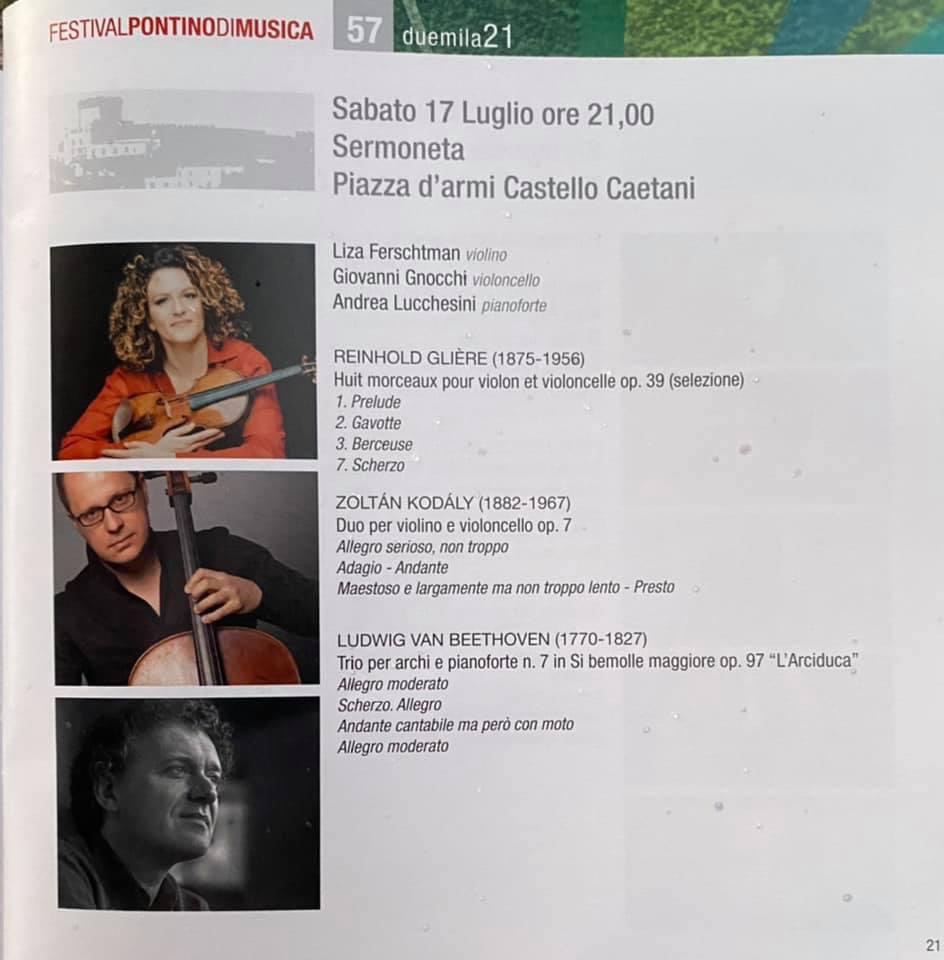
Ferschtman-Gnocchi-Lucchesini Trio in Sermoneta
Giovanni Gnocchi’s selfless dedication to music and his quest to help talented young musicians by playing together with them gave us a very welcome unannounced addition to the programme with a Requiem by David Popper dedicated to the great cellist Rocco Filippini who passed away earlier this year. Gnocchi too had taken part in a concert in 1995 when he was in the masterclasses of Rocco Filippini who together with Bruno Canino,Bruno Giuranna,Mariana Sirbu,Franco Petracchi and many other distinguished musicians maintained the great principles of Sermoneta as laid down in stone in the 60’s by Menuhin and Szigeti.

Involving Andrea Lucchesini too with the glorious intense sounds of the three cellos of Giovanni Gnocchi,Leonardo Notarangelo ,Luigi Visco and the piano resounding around the Stables of the Castle that Filippini knew so well for so many years.
Liszt recommended Popper for a teaching position at the newly opened string department at the Conservatory in Budapest where he participated in the Budapest Quartet with Jeno Hubay.He and Hubay performed chamber music on more than one occasion with Brahms including the premiere of Brahms’s Piano Trio in C minor op 101 in Budapest, on December 20, 1886.Popper was a prolific composer of cello music, writing four concertos a Requiem for three cellos and orchestra (1891) and a number of smaller pieces which are still played today.He was born in Prague in 1843 and was one of the last great cellists who did not use an endpin

Three pieces from the suite by Glière( born in Kiev in 1875)for violin and cello opened the announced programme.From the intense tone in the Prelude of Gnocchi’s cello resounding in this atmospheric space and with the searing beauty of Liza Ferschtman’s violin in the Berceuse disappearing to a whisper as the final mellifluous duet of the Canzonetta took over.
This was just a prelude to the great Kodaly duo that like his solo cello sonata is a remarkable monument to this much neglected Hungarian composer.I remember hearing André Navarra in 1985 give an unforgettable performance in Sermoneta of the Kodaly monumental solo sonata.Bartók and Kodály cultivated a distinct Hungarian musical identity, deeply rooted in folk sources. Bartók later extolled his colleague: “If I were to name the composer whose works are the most perfect embodiment of the Hungarian spirit, I would answer Kodály”.Violin and cello seems barely sufficient to contain the work’s muscular content, as though Kodály were dressing a giant in tight- fitting clothes. Though a relatively early work in Kodály’s broad oeuvre (a catalogue including some twenty chamber works, yet more exten- sive in the realms of vocal, choral, and pedagogical music), the duo nevertheless illustrates the essence of the composer’s mature musical language.
Primacy of melody is on display throughout the work. The cello begins the first movement with a proud, folk-like theme, proclaimed forte, risoluto; the violin comments with equally assertive double- and triple-stopped chords. A lyrical second theme appears, piano, tranquillo, paced by steady pizzicati.
From the grandiose awakening of the Allegro serioso to the deep lament of the Adagio and the sheer exhilaration and trancendental mastery of the Presto it was a masterly performance played as one.

It was the demonstration that Sermoneta’s noble musical values are in good hands with musicians dedicated to the musical principles that have always been the emblem of Sermoneta maintained so faithfully by the Cerocchi family.
From father Riccardo to daughter Elisa the flame ignited by the enlightened Caetani- Howard family in the 60’s is still shining brightly.

It was demonstrated with the inclusion of Andrea Lucchesini into this select group.A pianist who had impressed the legendary Shura Cherkassky when he was invited to listen to a young boy in Luciano Berio’s house in Tuscany.I had accompanied Shura to play in Empoli,the birthplace of Busoni, in the ‘90’s and he was most impressed by this student of Maria Tipo.
Lucchesini has gone on to have an illustrious career but always allied to the highest musical principles that have brought him to direct the renowned Academy in Fiesole and now the Filarmonica in Rome.
And so it was fitting that he should be passing on his knowledge to the next generation in the renowned courses in Sermoneta that have left such a sign and formed so many great musicians in the past.

It was the pure magic of the Archduke Trio that filled the air with refined music making from three great musicians listening so attentively to each other in a musical conversation of the highest calibre.How we are being bombarded in the Mass media by vulgarity and ignorance as virtuosi of the football pitch are passed the microphone and whose views are treated as gospel!It was a relief to hear the eloquence of the opening statement of one of Beethoven’s greatest works played with such aristocratic nobility on the piano and answered by the refined,passionate involvement of violin and cello.It created such magic from the outset.The interplay between the cello and violin in the Scherzo erupting into a mellifluous outpouring of glorious exhilaration before the deeply contemplative Andante cantabile leading to the exhuberance of the final Allegro moderato.

An extraordinary performance by three great musicians who after such an exhilarating performance insisted on sharing their ovation with the two young musicians who had opened this evening of sublime music making .
An evening dedicated to the memory of Rocco Filippini where the walls of this castle have absorbed so many of his masterly performances in the past.



